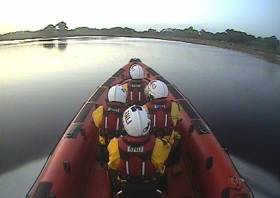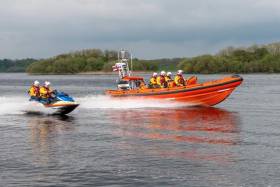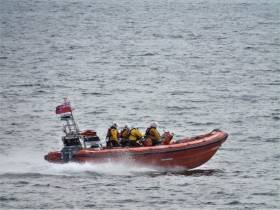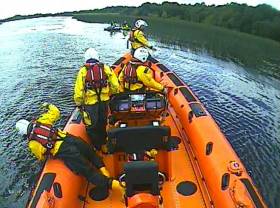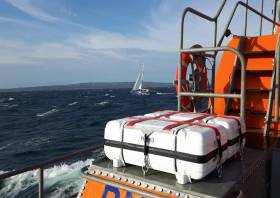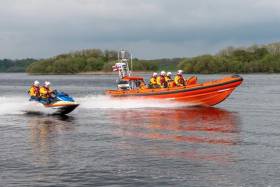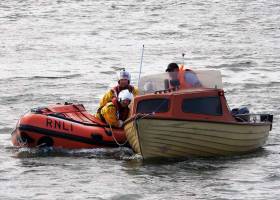Displaying items by tag: Carrybridge
Carrybridge RNLI Seeks New Lifeboat Volunteers For Lough Erne
Carrybridge RNLI is looking for new volunteer crew members to join its search and rescue service on Lough Erne.
The station, on the River Erne between the upper and lower loughs, is now calling on potential recruits to come forward and learn how they can get involved in helping the charity continue to save lives at sea and on inland waterways.
Later this month, on Thursday 21 November from 7pm, the lifeboat station will be hosting an open evening for all interested candidates to learn more.
Originally part of Enniskillen RNLI, Carrybridge RNLI was established in 2002 due to the increase in pleasure boating activity on Lough Erne.
In October 2015, a new station was officially opened and a larger Atlantic 85 lifeboat was placed on service in November 2017, to replace the older Atlantic 75 and to join the existing rescue water craft (RWC).
To date the lifeboat, Douglas Euan and Kay Richards, and RWC have launched 41 times on service in addition to weekly training exercises.
Stephen Scott, Carrybridge RNLI lifeboat operations manager, is now calling on any potential volunteers to come along to the open evening and find out more.
“We are looking for anyone aged 17 years and over who is willing to offer some of their free time to join what I believe to be one of the most exhilarating and rewarding voluntary services that is out there,” he said.
“While experience on the water is helpful, every volunteer receives first-class training from the RNLI and learns new skills which can benefit them in many walks of life. Lifeboat crew members need to have a reasonable level of fitness.”
Anyone who feels they have the time and commitment to volunteer for the charity which is on call 24 hours a day, 365 days a year, is asked to email Stephen at [email protected]
Carrybridge Lifeboats Launch To Help Two On Broken Down Vessel
Carrybridge RNLI's inshore lifeboat and rescue water craft (RWC) were launched last night (Monday 7 October) after 7pm to a vessel with two people on board which had suffered engine failure around half a mile upstream from the Killyhevlin jetty.
When the lifeboat Douglas Euan & Kay Richards and RWC arrived on scene, they proceeded slowly to the vessel's location close to the reed line.
Once the boat's condition was assessed, and with the owner's permission, the volunteer lifeboat crew set up a tow and brought the casualty vessel in to deeper water, and then onwards to Killyhevlin jetty.
Speaking after the callout, Chris Cathcart, helm at Carrybridge RNLI, advised all boat users to take proper care when plotting their trips on the water.
"Before setting out on your journey please plan your route and carry out regular checks of their vessels. Also have a means of calling for assistance if you find yourself in trouble. If you see someone in trouble on the water or are in difficulties yourself the number to dial is 999 or 112 and ask for the coastguard."
Carrybridge RNLI Exercise with Passenger Vessel, Inishcruiser
On Thursday 19 September, Carrybridge RNLI’s inshore lifeboat, Douglas Euan & Kay Richards held a towing, casualty care and mass evacuation exercise with the passenger vessel from Share Discovery Village, Inishcruiser. The exercise took place close to the Share Centre.
The weather couldn’t have been better with flat calm conditions.
When the lifeboat first arrived a tow was established for the volunteer crew to practise moving a boat as big. A side by side tow, a tow where the lifeboat is tied alongside another boat, was set up so the crew could then try turning the vessel. The much smaller lifeboat was able to complete this with ease.
The lifeboat and its crew then moved away from the Inishcruiser and waited until called for the next part of the exercise, casualty care. Already on the Inishcruiser were three volunteer crew who along with three crew from the lifeboat found a lady in a wheelchair that needed assistance but also a man, face down, with chest pain. Casualty care was administered to both casualties with the man who had a suspected heart attack being treated using the equipment carried by the lifeboat.
During this time the staff from Share along with lifeboat crew who had been acting as passengers, evacuated the passenger boat into two waiting boats which made several runs back to the centre. The lady in the wheelchair was lifted from her chair into the boat followed by the man with the chest pain who was transported back to the land in the lifeboat.
Speaking following the exercise, Stephen Scott, Lifeboat Operations Manager at Carrybridge RNLI said: ‘‘We would like to thank the staff from Share Discovery Village for helping to arrange this very valuable exercise. It gave our crew a great opportunity to work with a bigger vessel as well as working with a large amount of people including the two casualties who played the part extremely well. We would also like to remind everyone that if you see someone in trouble on the water or are in difficulties yourself the number to dial is: 999 or 112 and ask for the Coastguard.’’
Busy Weekend For Northern Ireland Lifeboats As Summer Season Ends
Northern Ireland lifeboat crews marked the end of the summer season with a number of callouts over the weekend.
On Saturday afternoon (31 August) Portaferry’s inshore lifeboat wad called out to reports that two Flying Fifteen keelboats had capsized on Strangford Lough.
On arrival it was found both vessels had been righted and were returning to shore, Portaferry RNLI said.
But while out on the lough, the lifeboat crew were also tasked to aid a 36ft yacht which had run aground on Don O’Neill Island some four miles away.
At the scene, the lifeboat crew ensured that all on the yacht and their dog were safety aboard their vessel and that there was no water being taken on.
The following afternoon (Sunday 1 September), the inshore lifeboat launched to a motorboat with two adults and three children that had run aground in the Narrows.
Another vessel had taken the casualty boat under tow to deeper water and the lifeboat crew followed up by escorting the motorboat to Portaferry Marina.
Elsewhere on Sunday, Carrybridge RNLI’s inshore lifeboat and rescue water craft were launched to a vessel with four on board which had grounded west of the Share Centre on Upper Lough Erne.
After carefully navigating the shallow waters and assessing the condition of the two adults and two children on board, the lifeboat crew checked the vessel for water ingress and none was found.
With the owner’s permission, the volunteer crew set up a tow line and proceeded to refloat the casualty vessel in deeper water.
The barge was again checked for water ingress and the steering and propulsion also checked before they were allowed to continue their journey.
Carrybridge lifeboat operations manager Stephen Scott reminded all boaters to plan their routes carefully using revenant charts to avoid difficulties in unexpectedly shallow waters.
Kilkeel Lifeboat Races To Speedboat Breakdown In Carlingford Lough Busy With Shipping
Kilkeel’s volunteer lifeboat crew worked fast to help clear a speedboat with engine troubles from a busy shipping lane yesterday afternoon (Tuesday 27 August).
The 16ft Bayliner, with one person on board, had broken down in Carlingford Lough and was in danger from incoming and outgoing shipping traffic, according to Kilkeel RNLI.
Kilkeel’s inshore lifeboat launched at 1.10pm headed south along the Co Down coast, and on arrival at the scene they found that the speedboat has been restarted.
Checking that the skipper was fine, they ensured there were no further issues before escorting the skipper back to his mooring in Greencastle.
The previous evening, Carrybridge RNLI’s inshore lifeboat Douglas Euan & Kay Richards and rescue water craft were launched to a vessel with its own engine difficulties some two miles downstream of the River Erne hamlet.
When the lifeboats arrived on scene, the casualty vessel — with two person on bard — was found floating close to the shoreline.
Once those on board were found to be well, a volunteer from the rescue water craft boarded their vessel to help set up a tow line and it was brought back to its private berth in the hamlet.
Carrybridge RNLI helm Chris Cathcart later advised all boat users: “Before setting out on your journey, please plan your route and carry out regular checks of their vessels. Also have a means of calling for assistance if you find yourself in trouble.
“If you see someone in trouble on the water or are in difficulties yourself, the number to dial is 999 or 112 and ask for the coastguard.”
Double Callout For Carrybridge Lifeboat On Busy Sunday Morning
Carrybridge lifeboat volunteers a busy morning on Sunday (4 August), starting with two personal water craft with engine issues close to Naan Island on Upper Lough Erne.
The relief inshore lifeboat and rescue water craft were launched at 11.33am to the stricken vessels, which one person on each craft, which were floating close to thee island’s shoreline, according to Carrybridge RNLI.
Both pilots were found to be well, and once their water craft were cleared of obstructions and fund to be in working order, they were sent on their way.
Just as the lifeboats were leaving the scene, however, Carrybridge RNLI reports they observed another personal water craft, this time with three on board, entering shallow water and at risk of grounding.
This third vessel was escorted into into deeper and safer water by the rescue water craft before it was allowed to continue its onward journey.
Speaking later, Carrybridge RNLI helm and press officer Chris Cathcart had advice for all boat users on Lough Erne and elsewhere.
“Before setting out on your journey please plan your route and carry the relevant charts and have a means of calling for assistance if you find yourself in trouble.
“If you see someone in trouble on the water or are in difficulties yourself, the number to dial is 999 or 112 and ask for the coastguard.”
Aran Islands RNLI rescued two sailors after their 38ft yacht got into difficulties off Gorumna Island in Co Galway yesterday morning (Thursday 27 June).
The station received the shout at 7.27am and the lifeboat David Kirkaldy launched under coxswain Tommy Dirrane with a full crew, heading straight for the 38ft yacht that had got tangled in lobster pots in the North Sound.
Conditions on the water were choppy with moderate seas and a 1.5m swell, and an east to north-easterly wind.
Once on scene, the lifeboat crew established contact with the two people aboard the yacht, and found that a local fisherman in the area had freed the vessel from the tangled lobster pots.
The lifeboat then escorted the yacht, which was under sail, as far as the mouth of Kilronan Harbour, where a tow line was established due to steering issues to guide the yacht alongside the pier.
Speaking after the callout, Dirrane said: “Thankfully, this was a good outcome to what could have been a different situation and we would like to commend the local fisherman who also helped.
“As we enjoy the good weather and the summer months ahead, we would like to remind anyone planning a trip to sea to always respect the water.”
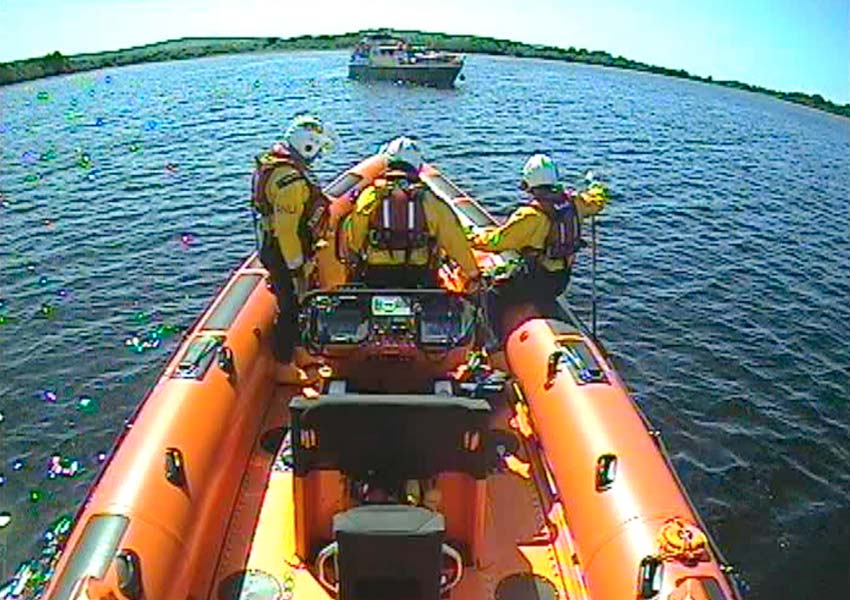 Carrybridge RNLI with the grounded vessel close to the Share Discovery Village | Photo: RNLI/Carrybridge
Carrybridge RNLI with the grounded vessel close to the Share Discovery Village | Photo: RNLI/Carrybridge
Elsewhere, Carrybridge RNLI launched its inshore lifeboat yesterday afternoon to aid a vessel with five on board that had run around around a mile north-west of the Share Discovery Village on Upper Lough Erne.
All on board were found safe and well, and wearing lifejackets. Their vessel was not taking on water, so a tow line was set up to refloat it in deeper water.
After checks for damage gave the all-clear, the vessel was allowed to continue its journey.
Lifeboat operations manager Stephen Scott added: “We would remind all users that before going afloat they should always carry a means of communication and to plan their voyage using relevant charts.
“If you see someone in trouble on the water or are in difficulties yourself the number to dial is: 999 or 112 and ask for the coastguard.”
A busy weekend for Carrybridge RNLI began at 7.39pm on Friday 14 June when the inshore lifeboat Douglas Euan & Kay Richards and rescue water craft were launched to a vessel with two people which had run aground about a mile north of Knockninny on Upper Lough Erne.
After checking that the people on the boat were safe and well, the volunteer crew checked the boat for water ingress and found none.
The vessel had refloated itself and a crew member was put on board to test the boat’s propulsion and steerage and all was found to be in working order. The vessel was then able to continue on its planned journey.
Two evenings later, at 8.59pm on Sunday, both lifeboats launched again to a vessel adrift, with the people on board waving for assistance in the area of Tamlaght Bay.
When the volunteer crew arrived on scene the vessel had managed to restart its engine and was proceeding back to Carrybridge. The craft was escorted back to the public slipway.
Shortly after arriving back at Carrybridge, the volunteer crew then assisted a person who had fallen into the water earlier in the evening.
Two crew members carried out a casualty care assessment and found the individual to be in good condition. The casualty’s vessel was escorted to its private marina with two crew members on board and safely secured to its mooring.
Chris Cathcart, helm at Carrybridge RNLI, said: “We would remind all boat users to respect the water, plan your passage before setting out, and take particular care whilst navigating.
“If you see someone in trouble on the water or are in difficulties yourself the number to dial is 999 or 112 and ask for the coastguard.”
At 1.14pm on the Saturday 20 April Carrybridge RNLI’s inshore lifeboat, Douglas Euan & Kay Richards and Rescue Water Craft (RWC) were launched to a vessel with two people which had run aground North West of Knockninny.
Winds were Southerly, Force 0. Visibility was excellent with a part cloudy sky.
The lifeboat and RWC arrived with the casualty vessel and after checking the people on the boat where ok the volunteer crew checked the boat for water ingress and found none. With the owner’s permission, the vessel was refloated and towed into deeper water and again the boat was checked for water leaks as well as the steering and propulsion checked and all was found to be ok.
The vessel was then able to continue on its planned journey.
Whilst the lifeboat and RWC were returning to the station the crew were alerted by another vessel with two people on board which had broken down. The crew assisted the boat by towing it back to a private marina.
Speaking following the call out, Stephen Scott, Lifeboat Operations Manager at Carrybridge RNLI advised all boat users: ‘to enjoy the fantastic weather over the holiday period, but as it is for many the start of the boating season to carry out regular maintenance checks and to plan their voyage using relevant charts. We would also remind all water users to wear lifejackets and to respect the water. If you see someone in trouble on the water or are in difficulties yourself the number to dial is: 999 or 112 and ask for the Coastguard.’’
Wicklow Lifeboat Aids Angling Boat With Mechanical Failure
#RNLI - A small angling boat with one person on board was towed to safety by Wicklow RNLI after it got into difficulty near Wicklow Head on Wednesday evening (8 August).
The angler had earlier departed from Wicklow Port for a day’s fishing along the coast, but was unable to get the engine into gear to return to the harbour.
The inshore lifeboat launched shortly after 6pm with helm Vinnie Mulvihill and crew David O’Leary and Graham Fitzgerald, and located the drifting craft near Wicklow Head eight minutes later. Weather conditions at the scene were calm with a northerly wind force three.
The angling boat was taken in tow back to Wicklow Harbour and the angler was landed safely ashore.
Elsewhere, Clifden RNLI continued what’s been a busy August when the volunteer lifeboat rescued a boy separated from his kayak at Omey Island earlier on Wednesday afternoon.
The youngster and his friend were holidaying on the island in Claddaghduff with their families, who raised the alarm when one of the boys was seen in the water with his friend trying to help him.
Following the coastguard request after 2.30pm, the Atlantic 85 lifeboat launched from Clifden while the D Class lifeboat travelled by road and was launched at Claddaghduff. Winds were Force 6 and gusting to 7 at the time.
When the Atlantic 85 reached the scene, they found people waving from the eastern shore of the island and saw that the two boys involved had made it ashore to another beach in the area, where some other visitors were assisting them.
Clifden RNLI helm Thomas Davis manoeuvred the lifeboat close to the shore and crew member James Mullen then swam to attend to the boys before reuniting them with their families. They were cold and shaken after the ordeal but otherwise unharmed.
Speaking after the callout, Mullen said: “We were really glad to have been able to assist these lads and their families today and always encourage anyone concerned to raise the alarm as quickly as possible.
“Conditions at sea in this area can change rapidly even for experienced water users and we are always on hand to help where we can.”
The RNLI advise all kayakers to always carry a means of calling for help and to keep it in reach at all times.
More recently, Carrybridge RNLI’s rescue water craft and inshore lifeboat Douglas Euan & Kay Richards, were requested to launch by Belfast Coastguard to assist a man who was disorientated whilst navigating Tamlaght Bay in Upper Lough Erne in the early hours of this morning, Friday 10 August.
And Larne RNLI’s all-weather lifeboat and inshore lifeboat crews recently carried out a training exercise to simulate a casualty care and extraction scenario.


